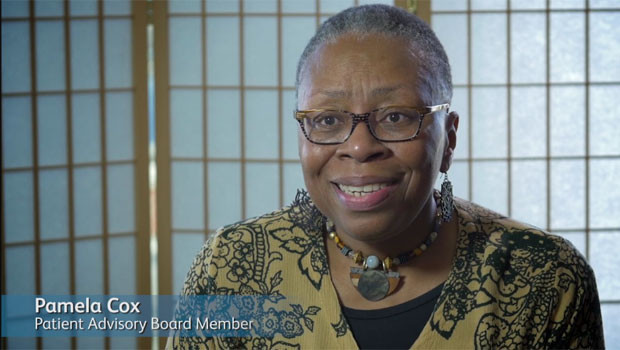Patients power SIMBA research on breast cancer, mammograms, breast MRIs

SIMBA patient advisory board member Pamela Cox.
A new video shows how patient engagement takes center stage in Dr. Karen Wernli’s study of breast cancer imaging for women who’ve had the disease before.
When GHRI’s Karen Wernli, PhD, launched the SIMBA study in 2013, she never imagined her team would become a model of successful patient engagement in research.
SIMBA, which stands for Surveillance Imaging Modalities for Breast Cancer Assessment, is a study about the use of mammography and breast MRI in women who have finished active treatment for breast cancer. The study aims to shed light on an important question these women and their doctors face: What are the costs and benefits of using mammography alone versus mammography plus MRI to look for new breast cancers that could develop?
SIMBA’s funding comes from the Patient-Centered Outcomes Research Institute (PCORI), which requires researchers to involve patients in study design and implementation. PCORI has recognized SIMBA for its exemplary approach to patient engagement. SIMBA was also featured at the 2015 Stanford Medicine X Conference and PCORI’s first annual meeting.
SIMBA's secret to patient engagement
What’s SIMBA’s secret for getting patients so involved in all parts of the project? Dr. Wernli and her team have been asked that question so many times that they decided to make a video to tell their story.
Their new five-minute video, “Making Medicine Better By Working Together,” explains the some of the key ingredients in SIMBA’s success. At the top of the list is a strong ongoing relationship with SIMBA’s two patient partners, who serve as study co-investigators, and its 11-member patient advisory board. The strength of this relationship comes from a foundation of mutual respect and inclusivity. In the video, we hear first-hand what it’s been like for these patients to be part of SIMBA and how it has impacted the research.
In the words of one advisory board member, “A lot of people have knowledge, but you don’t know how to share that knowledge. I believe SIMBA created that platform.”
A team effort
The video also features members of SIMBA’s scientific team and various physicians who serve on its stakeholder panel, which includes radiologists, oncologists, breast cancer surgeons, primary care doctors, and others. While SIMBA creates important opportunities for these doctors and scientists to come together across disciplines and learn from each other, the key “ah-hah” moments have come from listening to direct patient input.
“They provide insights and ask questions that none of us think to ask as researchers,” explains study co-investigator Louise Henderson, PhD, MPSH, from the University of North Carolina—Chapel Hill. “They also help bring us back to ‘What is this going to mean for the patient?’”
Watch the video “Making Medicine Better By Working Together,” to learn more about SIMBA’s unique brand of patient engagement.
“Making Medicine Better Together By Working Together” was produced by SIMBA Project Manager Susan Brandzel, MPH, in collaboration with Dr. Wernli, GHRI Research Administration Supervisor Melissa Rabelhofer, and videographers from Gypsy Soul Productions, Inc.



